Hens and Chicks are fast-growing succulents. They mature within a couple of months after planting. They start producing offsets once the temperature starts getting 58°F. But the problem occurs when the plant doesn’t grow despite getting all its requirements.
So, in this article, we shall discuss why are your hen and chick plants not growing and how you can fix the same.
In general, Hens and Chicks stop growing due to specific problems like extreme temperature, low lighting, pest infestation, or watering problems. To fix the problem of stunted growth, provide bright direct sunlight, fertilize and water the plant as needed and keep the pests at bay.
These problems need fixation quickly. Else they will progress and affect the plant’s health to a great extent.
It is pretty confusing to understand why there is no growth in the Hens and chicks.
This article will let you understand the causes of no growth in the Hens and Chicks. Besides, we will share some care tips to prevent the problem.
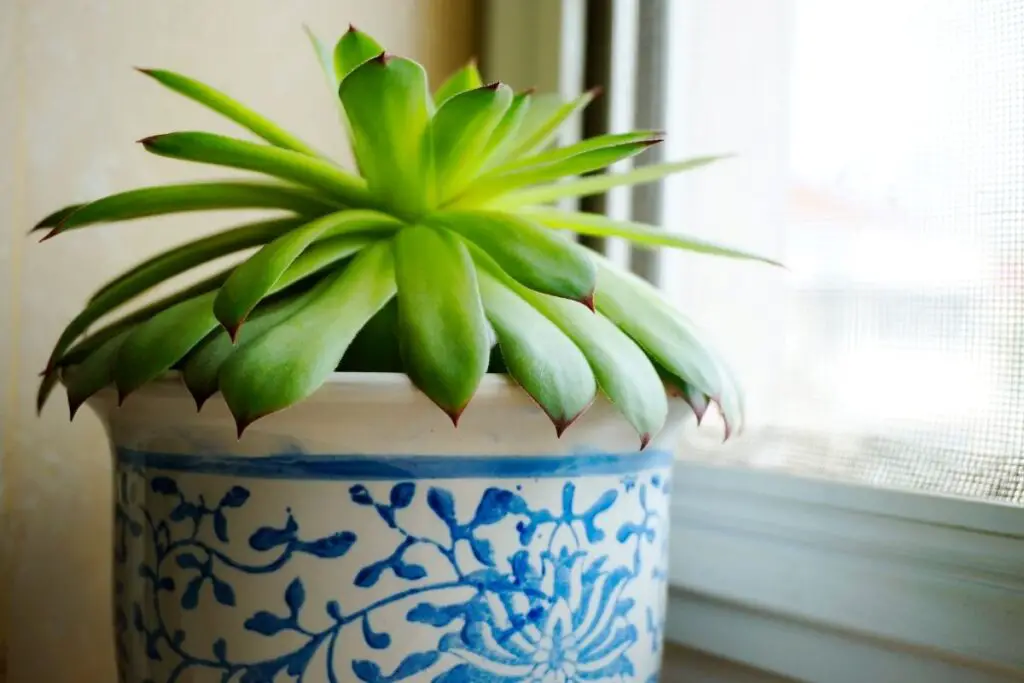
Why are my Hens and Chicks not growing?
The reasons behind no growth in the Hens and Chicks are several. Some are natural, and some are problems that require fixations.
Dormancy
It is one of the foremost causes behind the Hens and chicks not growing. When the temperature starts dropping below 40°F, the plant slows down its growth gradually.
In the winters, especially if your region witnesses snowfall, your Hens and chicks will stop their growth.
The plant will not die even if the temperature drops below -40°F.
They will switch on their survival mode and stop growing.
This is the plant’s natural process of conserving energy to use during its upcoming growing season, i.e., spring.
Some people get confused about this winter dormancy phase.
When they don’t see any development in the plant, they try to induce growth by watering and fertilizing.
But, doing these only degrades the plant’s health and causes rotting.
Cut back watering from the second half of the fall when the temperature drops.
Check your calendar to know the expected winter and frost arrival in your region and take steps accordingly.
Also read: Can You Leave Hens And Chicks Outside In Winter?
Exposure to extreme temperatures
Hens and Chicks will stop their growth and protect themselves when exposed to extreme temperatures.
In the previous point, I already discussed the results of exposure to cold temperatures.
The same thing can happen if they receive too high temperatures.
If you live in a region with temperatures nearly 90°F, it remains nearly the same at night.
The plant will go through a semi-dormant phase.
The plant will suffer sunburns by sitting under the direct sun in some instances.
You will understand when they stopped their growth by their behavior.
The rosette will shrink and close inwards as if trying to protect itself from the extreme temperatures.
If the plant stays semi-dormant, double-check the soil moisture before watering.
Since they are semi-dormant, they might be consuming less water.
Also read: Hens And Chicks Temperature Tolerance: (How Cold, How Hot?)
The pot is smaller than the plant.
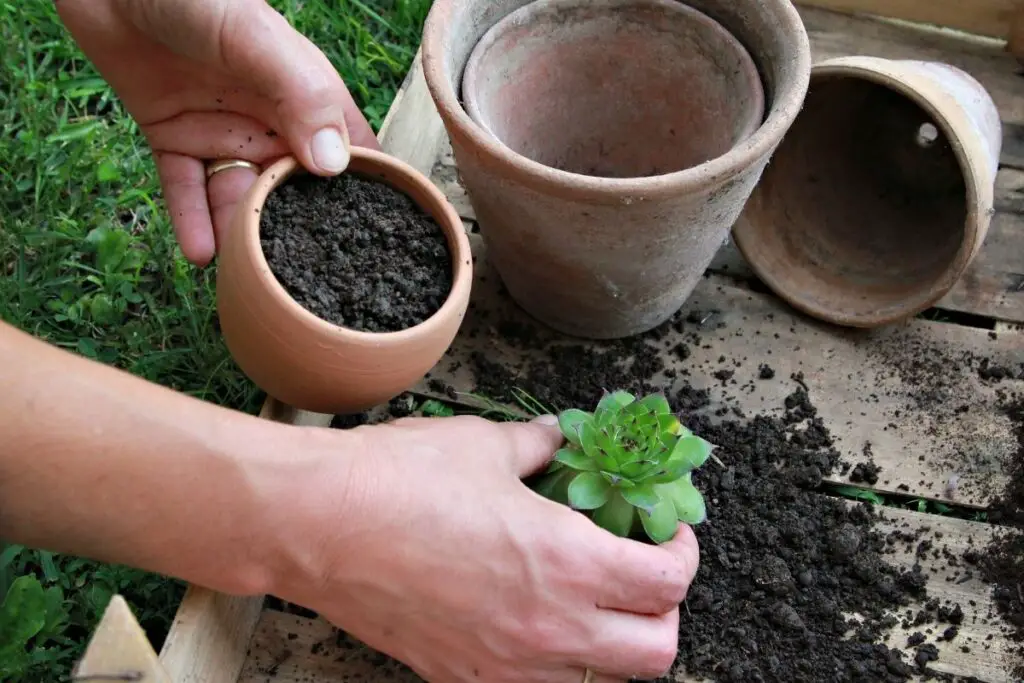
Many people grow these succulents in containers because they look great.
But, some people keep the potted Hens and Chicks outdoors to let them have their growing environment.
Hens and Chicks do great outdoors, under the sunlight.
Remember that you must repot the Hens and Chicks to a bigger container to let them breathe, grow and multiply.
When you buy a plant with a pot, it stays in a small planter, depending on the size.
Within a few months, they will outgrow their pots and need repotting.
If you don’t shift the plant, it will slow its growth and ultimately stop growing.
Shift them to a new container once you find the roots are growing out of the drainage holes.
Also read: When To Repot Hens And Chicks? (Signs, How-To & More)
Sunlight exposure
Adequate sunlight is an essential factor for the better development of the Hens and Chicks.
Some varieties will need full sun for 8-10 hours daily, whereas others will need only 4-6 hours of sunlight.
Too much or too little exposure can affect the plant’s smooth growth.
Signs of too much sunlight:
Closed rosette
The sunlight intensity also increases the temperature.
Accompanied by high temperature, too much light will lead to no growth in the plant.
Brown patches on the leaves indicate sunburns.
Signs of low light:
- No development in their growth.
- The leaves turn pale green.
- Plant escalating
- Signs of rotting.
Also read: How Much Sun Do Hen And Chicks Need? (Light Requirement)
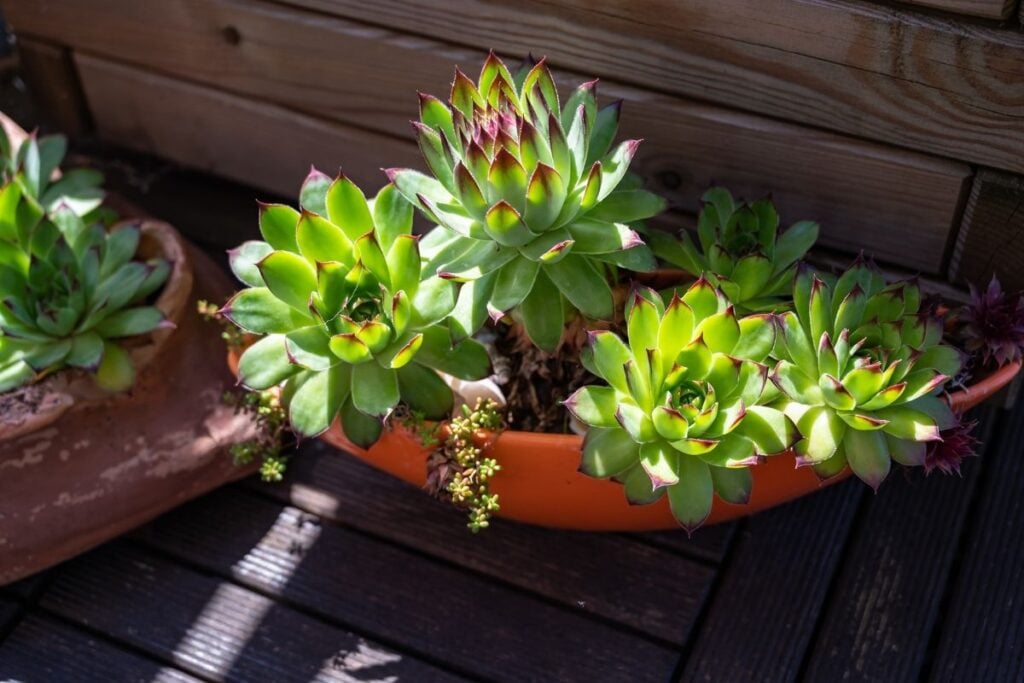
How to fix light problems?
If you don’t want to see your plant struggling for too much or too little sunlight, you should think about it before planting.
First, you should know that Hens and Chicks will require at least 6 to 8 hours of direct or filtered sunlight, depending on the variety.
Then you must select an ideal spot in your garden so that they don’t suffer any light issues.
Try to check for three directions – southern, western, and eastern.
These three directions provide maximum sunlight and are applicable for the northern hemisphere.
For the southern hemisphere, it’s the same.
An exception is to check north instead of south for maximum sunlight.
Planting them in a sunny place will save you time.
Otherwise, you’ll have to transplant them to a new location.
However, the effort is relatively less during too much light.
Fixing the shading net to filter the sunlight will do the job.
Don’t think that they don’t need light because of being small.
On the contrary, lots of sunlight improves their health and develops their colors.
Looking for gardening supplies? We have tested 100's of products before recommending them to you guys. Check out our best pick below:
| Image | Gardening Supplies | Best Price? |
|---|---|---|
 Top
Top Top
Top | Raised Garden Bed Kit | Check On Amazon |
 | XLUX Soil Moisture Meter, Plant Water Monitor, Soil Hygrometer Sensor for Gardening, Farming, Indoor and Outdoor Plants, No Batteries Required | No Results |
 Top
Top Top
Top | 82 Pcs Garden Tools Set and Extra Succulent Tools Set | Check On Amazon |
 | Joeys Garden Expandable Garden Hose with 8 Function Hose Nozzle, Lightweight Anti-Kink Flexible Garden Hoses, Extra Strength Fabric with Double Latex Core, (50 FT, Black) | No Results |
 Top
Top Top
Top | Dual Chamber Compost Tumbler | Check On Amazon |
 Top
Top Top
Top | Sunnyglade Plant Stakes | Check On Amazon |
 Top
Top Top
Top | Organic Cold Pressed Neem Seed Oil | Check On Amazon |
 Top
Top Top
Top | Mighty Mint Gallon :-Insect and Pest Control Peppermint Oil | Check On Amazon |
 Top
Top Top
Top | Scotts DiseaseEx Lawn Fungicide | Check On Amazon |
 Top
Top Top
Top | Jacks Classic 20-20-20 All Purpose Fertilizer | Check On Amazon |
 Top
Top Top
Top | 30,000 Seeds Pollinator Attracting Wildflower Mixture | Check On Amazon |
 Top
Top Top
Top | Survival Vegetable Seeds Garden Kit-Over 16,000 Seeds | Check On Amazon |
Watering issues
Both overwatering and underwatering can stop the growth of Hens and Chicks.
Such kind of stress affects and interrupts their smooth growth, due to which they stop growing.
Slowly, they will begin to deteriorate.
These plants can store water in the leaves.
So you don’t need to water them daily.
Water whenever the soil gets dry to keep them moist.
You should also not keep them thirsty for too long.
They will stay without water mainly for a week or two.
Symptoms of overwatering:
- Yellow leaves, especially the lower leaves.
- Soft and mushy leaves
- Leaves drop when touched
- The soil is too damp
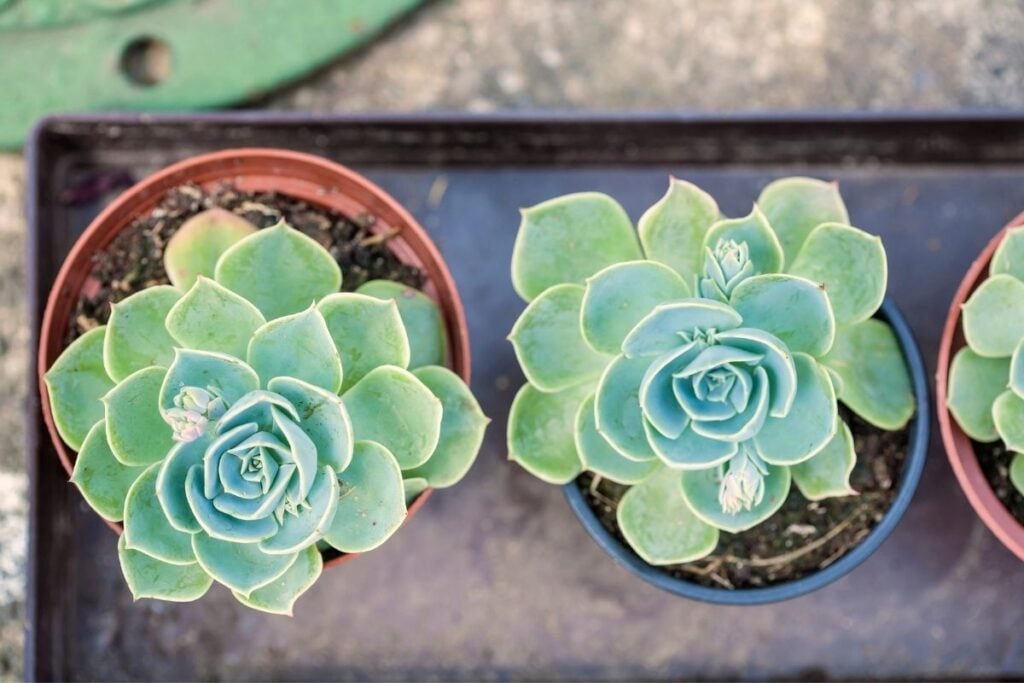
Symptoms of underwatering:
- Dry yellow leaves
- Shrunken and wrinkled leaves
- Soil feeling dry and hard
Also read: How Much Water Do Hens And Chicks Need? (Underwatering+Overwatering)
How to fix watering issues?
These steps will help you water the right way.
- Check the moisture level of the soil before watering.
- Allow the soil to get dry before the next watering.
- Water the plant when the top 1-2 inches of the soil feels dry.
- Don’t increase the gap between watering. Maintain a gap of at least 7 to 14 days.
- Give 1 inch of water 1-2 times a week throughout the growing season, depending on the weather conditions.
- Cut back watering during winters.
If you have overwatered:
- Watch for the signs, check the soil, stop watering, and wait for the plant’s reaction.
- If the plant suffered root rot, take the plant out, trim off the roots and plant them at a dry place.
If you have underwatered:
- Give your plant a good drink.
- Sometimes, poor drainage is also responsible for overwatering. Add porous materials like sand, gravel, perlite, or pumice with the garden soil to improve drainage.
Hens and Chicks are underdeveloped.
While separating the offsets, pull them off or cut the joining between the mother and babies.
Then you trim the long stem and plant it in the soil.
You must have noticed that they did not develop any roots.
They will need time to develop roots.
So, when you see your plant is not growing, it means that the roots are not yet fully grown.
Unless the roots are grown fully, do not expect to see new leaf growth in the plant.
The same happens when you treat root rot.
Sometimes, the plant takes much longer to grow roots than they usually take.
It is because you must have separated and planted those young offsets that are less than 1 inch in diameter.
The smaller the young plants are, the more time they will grow.
Also read: How Fast Do Hens And Chicks Grow?
Pest infestation
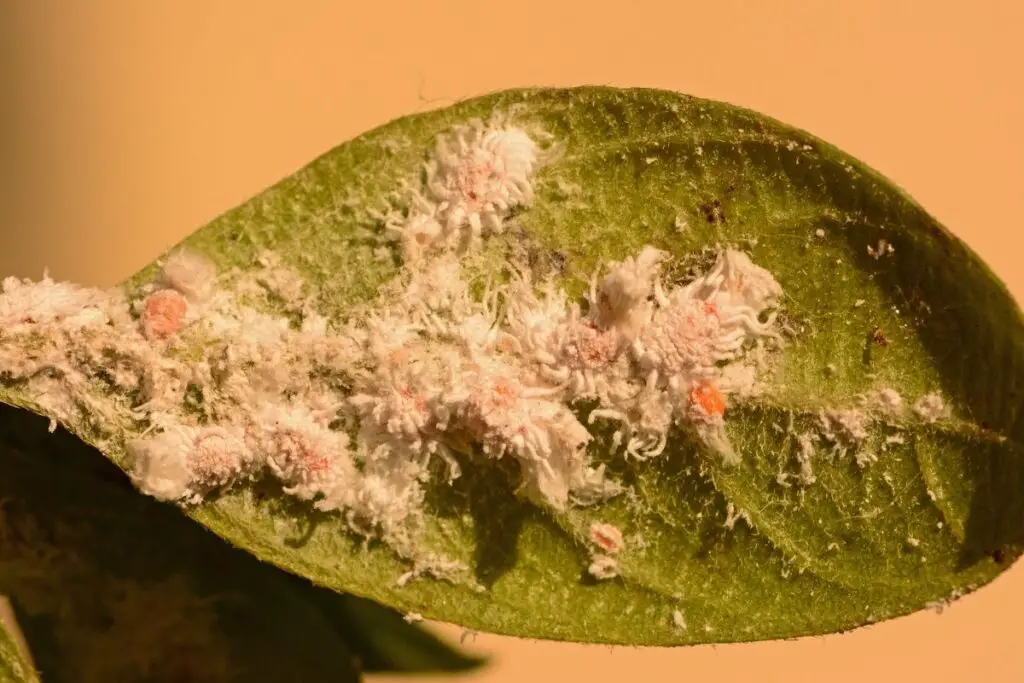
Once the bugs find interest in your plant, they will not leave until treated with pesticides and insecticides.
Pests suck up the juices from the broad leaves, making the plant weak and tired.
As a result, the plant’s energy gets drained and thus impacts its growth.
Aphids, mealybugs, scales, and spider mites are common culprits behind zero growth and development in the Hens and Chicks.
How to get rid of bugs?
There are various ways of removing bugs like:
- Give the plant a good shower.
- Handpick the bugs.
- Spray neem oil or soapy water. Exposing the plant to direct sunlight after applying neem oil burns the leaves. Do it at night to avoid burns.
- Insecticidal soaps like Safer Soap.
- Apply rubbing alcohol in the infected area.
- If everything fails, use chemical pesticides and insecticides.
Also read: Hens And Chicks Pests (Common Bugs+How To Get Rid)
What care tips should I follow to stimulate the growth of Hens and Chicks?
Following the proper care tips will not only keep your Hens and chicks safe from troubles but will also help stimulate their growth.
Now, let’s dive into the care tips:
Let them have adequate sunlight but not too much.
Make sure to plant them at the sunniest spot in your garden.
Hens and Chicks should at least receive 6-8 hours of sunlight, either direct or filtered, depending on the variety’s needs.
Ensure that the spot you select is free of all blockages like buildings or trees so that these obstacles cannot restrict the reach of sunlight.
To protect from sunburns, fix a shading net to filter the sunlight.
Water when needed.
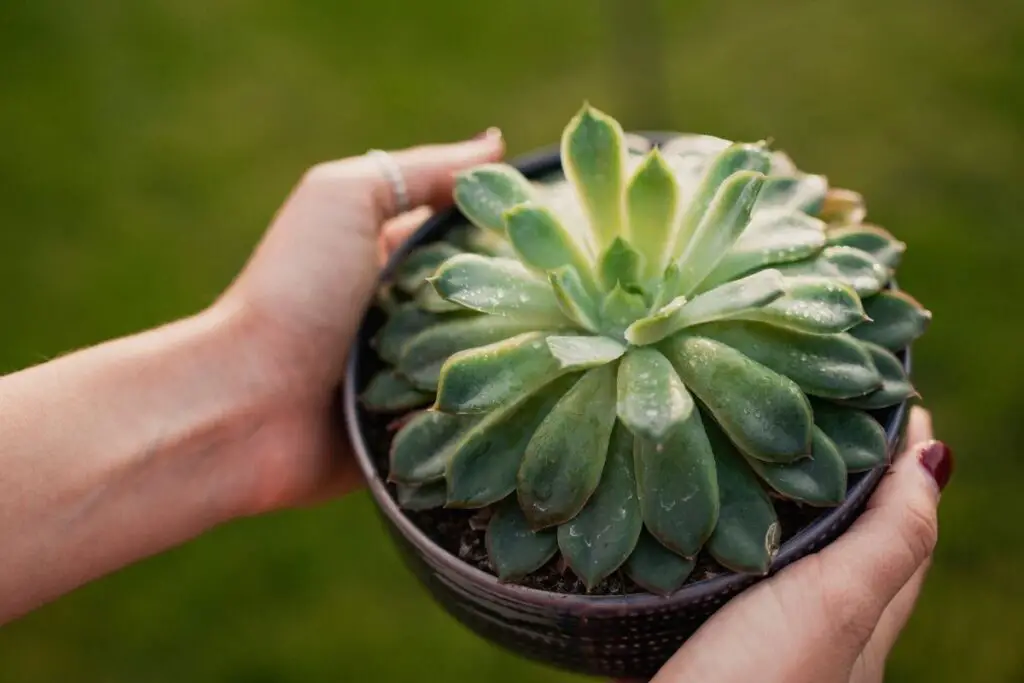
The best way to understand the watering needs of Hens and Chicks is to check the soil’s moisture level.
When the top 2 inches of the soil dry out completely, give water to the plant.
Another method is to drench the soil entirely with thorough watering.
Again opt for watering when all the soil has dried completely.
It will neither let the soil dry for prolonged periods nor suffer overwatering.
Generally, these succulents are watered at least 1-2 times a week during the spring and summer.
Cut back watering frequency when the temperature gets cold.
Instead of following a strict regime, follow the above two methods for good results.
Use well-drained soil.
The soil bed for Hens and Chicks needs to be well-drained and not highly nutritious.
Mix gritty materials like sand, gravel, perlite, or pumice for good drainage.
You can use:
- 25% Potting soil
- 50% Sand
- 15% Perlite/Vermiculite
- 10% Compost/Worm casting
For potted Hens and Chicks, use cactus and succulent soil.
Also read: What Kind Of Soil Do You Use For Hens And Chicks? (+Best Soil Mix)
Fertilizing can help stimulate their growth to some extent.
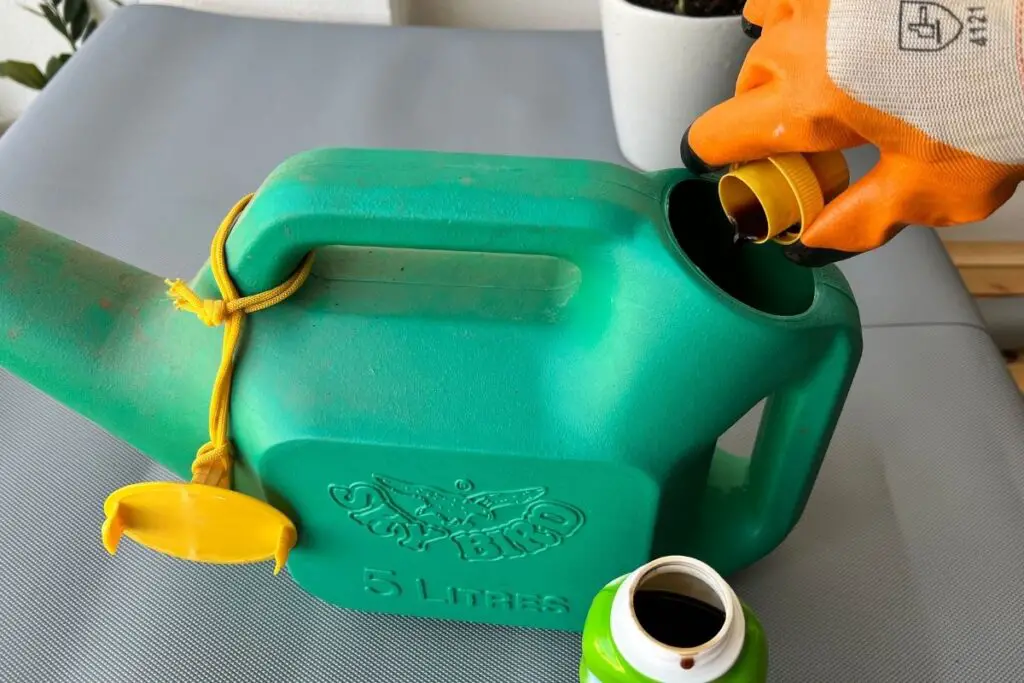
Generally, Hens and Chicks don’t require fertilization.
They release a chemical named auxin.
It helps them boost their growth within. That is why Hens and chicks will easily thrive with rocky soil.
But when they don’t grow in their growing season despite everything right, fertilize them slightly during the months of spring.
It helps them to start their growth and increase the rate.
Don’t do it during the winter because winter dormancy is normal.
Also read: Do Hens And Chicks Need Fertilizer? (+Best Fertilizer For Hens And Chicks)
Let them stay outdoors.
Some people grow Hens and Chicks in containers and keep them outdoors.
But when the temperature reaches its extreme level, people take them indoors.
Instead of doing that, keep them outdoors and let them face the stress.
It makes them feel that they are in their natural habitat.
Filtering the direct sunlight by fixing shading nets during the summers is enough.
Soon, they will get adjusted to the environment and start growing.
Look out for pests
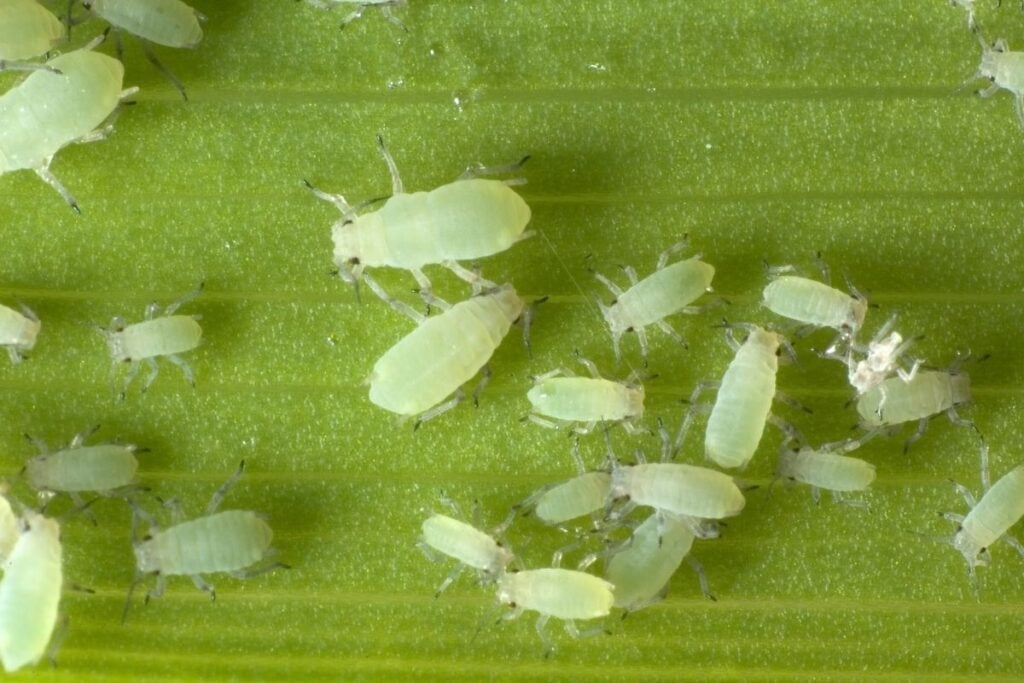
Bugs sucking the juices from the plant will stop the plant’s growth.
Since the leaves are plumpy due to water storage, the bugs will love feeding on them.
Check out for pests regularly.
The moment you notice any damage sign, treat them immediately.
Final thoughts
Observe your plant’s reaction to understand whether it is facing any problem. It will also encourage quick treatment of the plant. If you continue neglecting the plant because it is hardy and resistant to various insecurities, it will eventually kill your plant.
If the plant stops its growth due to extreme temperatures, don’t increase its requirements. The Hens and Chicks will go through a natural dormancy during the winters and semi-dormancy in the summers (90°F). Double-check the plant’s condition and then take steps.
Hens and Chicks not growing – FAQs
How much time do Hens and Chicks take to grow roots?
When you separate the young offsets from the mother plant, they will take a minimum of 30 to 45 days to grow roots.
The same goes for the rootless plants whose roots need removal due to root rot.
Only after that will you notice new growth in your plant.
It might take more than 45 days for the offsets to grow if they are too small.
How to grow more Hens and Chicks?
Separate the young babies from the mother plant and plant them to the ground.
Shade them for 1-2 weeks until they grow roots.
Since they already hold water in their leaves, start watering after 3 to 4 days of planting.
Reference: Wikipedia, Iowa State University of Science and Technology, The University of Arkansas Division of Agriculture, NSDU, The Ohio State University, Missouri Botanical Garden.
